Femia > Health Library > Your cycle > Health > Egg white discharge: What it means for your cycle and fertility
Egg white discharge: What it means for your cycle and fertility
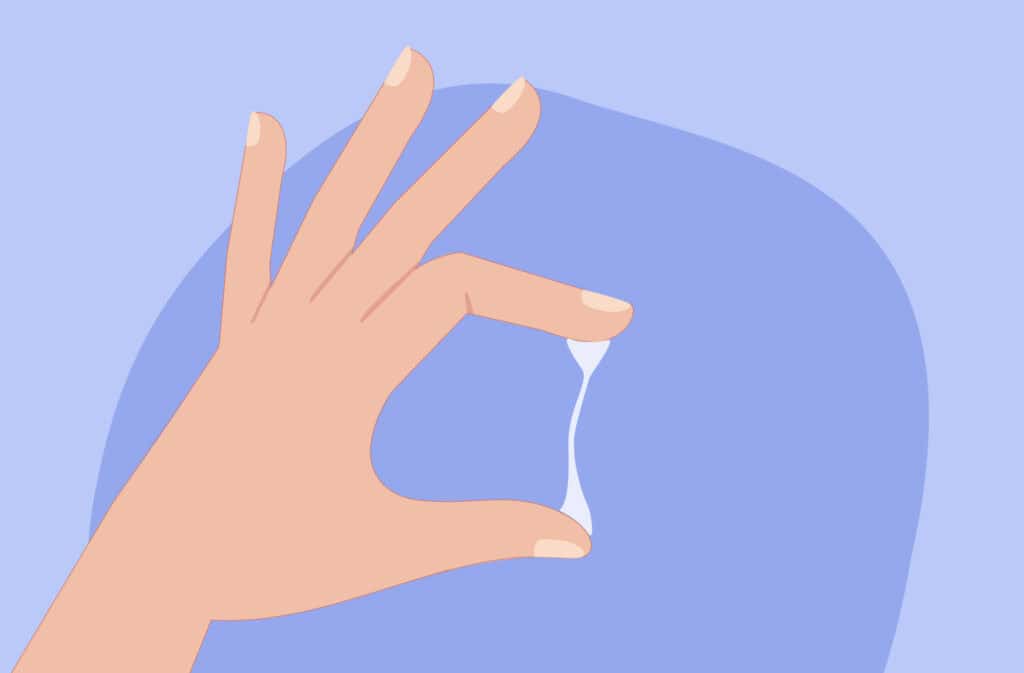
- Updated Mar 2, 2025
- Published
CRAFTED BY HUMAN
Crafted by human At Femia, we provide accurate and up-to-date information at every stage of your journey, from trying to conceive, pregnancy and postnatal support. All content is created by a real person based on in-depth research and own professional experience. Femia ensures that you will receive expert advice, strict accuracy and a personalized approach from our authors/medical experts. Learn more about our editorial policy.
FACT CHECKED
Fact checked At Femia Health, we maintain the highest standards of editorial excellence in delivering content focused on helping you conceive, guiding you through pregnancy, and supporting you postpartum. Explore our content review principles to learn how we ensure the accuracy and quality of our health and lifestyle tips for every stage of your journey.
- Egg white discharge is clear, stretchy mucus that typically indicates ovulation and peak fertility.
- It helps sperm travel through the cervix to fertilize an egg.
- Normal discharge varies throughout the menstrual cycle due to hormonal changes.
Vaginal discharge is a clear, white, or close-to-white fluid (mucus) produced by your uterus, cervix, and vagina. This fluid is made of cells and bacteria. It has two primary purposes—1) to lubricate your vagina, and 2) to help your body get rid of bad bacteria and infections.
In general, it’s considered normal to see your mucus range from watery and clear to whitish, sticky, and thick. These changes are typically caused by hormonal changes that occur at different stages of your cycle. However, sometimes certain changes in discharge color, consistency, amount, or smell might signal an infection, disease, or some other change to your reproductive health. This is why tracking your mucus and understanding its changes is so important for detecting possible issues early on.
In this article, we’ll focus on defining egg white discharge, in particular. You’ll learn what egg white mucus means, when it might naturally occur in your cycle, its role in your fertility, and other types of discharge to look out for.
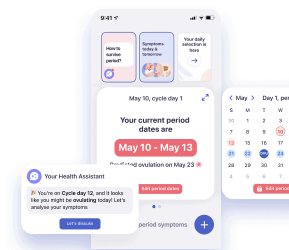
What is egg white discharge?
Egg white discharge is a clear, slippery, and stretchy mucus that resembles raw egg whites.
Typically, this kind of discharge appears around the time of ovulation (10–14 days before your period) to support the conception process because that’s when you are highly fertile.
What does egg white discharge mean?
The changes in the consistency and color of vaginal discharge are a natural part of getting through your cycle.
Your discharge consists of multiple elements, such as secretions from the cervix, secretions from sebaceous glands, vaginal squamous epithelial cells, Bartholin’s glands, and sweat, which give it a complex mix of viscoelastic properties. Affected by hormonal changes throughout the cycle, these properties change structurally, giving your discharge a different consistency or color.
So what does egg white discharge mean, in particular? It could be a sign of the following changes in your body:
- You’re in your ovulation stage (or close to it). Before and during ovulation, your vaginal discharge is primarily made of cervix mucus, which can resemble a raw egg white and is a sign of peak fertility.
- You’re sexually aroused. Physical sexual arousal in females is accompanied by increased blood flow to the genitalia and enhanced vaginal discharge released for better lubrication and painless penetration. The vaginal discharge during sexual arousal is made of plasma and secretions from the uterus, and vestibular and Bartholin’s glands. Hence, it might be natural to notice egg white discharge after sex (or before it).
- You’re pregnant. Egg white discharge (also known as leukorrhea) is a common early pregnancy sign. It occurs due to hormonal changes in early pregnancy and may originate from the ovaries, fallopian tubes, vagina, or, most commonly, the cervix.
👉Find out more: Pink discharge: Causes and what you can do about it
Egg white discharge and your cycle
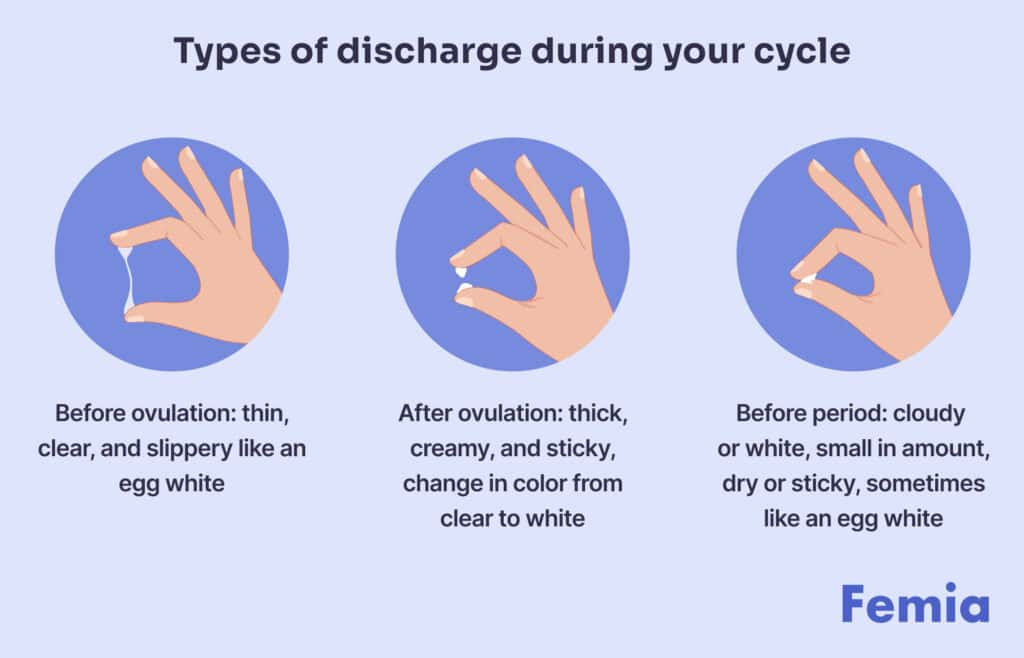
Hormonal levels naturally change throughout each stage of your menstrual cycle, affecting your vaginal discharge. Here’s how it can change at every stage:
- Before ovulation. Before and during ovulation, the hormone estrogen is peaking in your body. As seen from estrogen therapy, this hormone tends to enhance the overall amount of vaginal discharge. Hence, it’s natural to notice a larger amount of vaginal fluid, typically thin, clear, and slippery like an egg white, right before ovulation.
- After ovulation. Once your fertile window closes, estrogen levels should begin to decrease, making progesterone the dominant hormone. Progesterone is the core hormone of the second half of your menstrual cycle that tends to decrease fluid secretion. Hence, after ovulation, your vaginal discharge can appear thick, creamy, and sticky, changing in color from clear to white and decreasing in amount.
- Before menstruation. Typically after ovulation (days 14–28 of your cycle), vaginal discharge is cloudy or white, small in amount, and dry or sticky due to peaking levels of progesterone. That said, it is sometimes normal to notice egg white discharge before your period due to hormonal fluctuations or as a sign of early pregnancy.
Egg white discharge and fertility
Egg white mucus released before and during ovulation plays a significant role in your reproductive system. Apart from indicating the peak of fertility, egg white discharge is proven to affect sperm mobility.
Studies have shown spermatozoids to be more “active” in cervical mucus, which enables them to swim to an egg twice as fast.
Simply put, egg-white-like mucus in ovulation helps sperm move through the cervix to fertilize an egg. Outside of ovulation, this type of discharge performs another important function of keeping sperm and other substances from getting into the cervix.
👉Find out more: Watery period blood: A sign of pregnancy or health issue?
Other types of discharge to know
Changes in vaginal discharge, albeit natural and healthy, could sometimes indicate infections and other health conditions. That’s why keeping an eye on your discharge throughout the entire cycle is important for staying aware of your health.
Here are the key discharge types you need to know about:
- Milky discharge. Milky discharge typically has a similar egg-white-like consistency but is thinner and has a slightly white color. What is the milky discharge meaning? It’s generally a healthy kind of discharge that typically appears when your body is preparing for ovulation. It might also be an early sign of pregnancy.
- Clear, jelly-like discharge. Clear and stretchy, jelly-like vaginal discharge is basically what we call egg white discharge. This is your “fertile” mucus that occurs during ovulation and helps sperm move smoothly through the cervix to fertilize the egg.
- Creamy discharge after ovulation. After ovulation, you step into the luteal phase of your menstrual cycle. This phase lasts for around 14 days until your next periods start. During this time, the estrogen levels that peaked during ovulation decrease, making progesterone your predominant hormone. Since there is no need for sperm to move through the cervix and fertilize the egg, progesterone decreases fluid secretion. Hence, you can naturally notice drier, creamy discharge after ovulation.
- Jelly-like discharge after sex. Clear, stretchy, jelly-like discharge is typical after sex. It’s the cervical mucus you produced during sexual arousal for greater lubrication. If it’s slippery and watery, it might also signal your fertility—that you are or are close to ovulating.

Questions from the Femia community
Can egg white discharge occur if I’m not ovulating?
Most frequently, this kind of discharge appears before or during ovulation. However, although rare, it can occur outside of ovulation due to hormonal fluctuations or even certain health conditions.
Is egg white discharge a sign of pregnancy?
Due to hormonal changes, egg white discharge is a common sign of early pregnancy. However, most often, it’s just a sign of ovulation.
Does egg white discharge mean I’m fertile every month?
Yes, generally it’s a sign of the upcoming or current ovulation that also indicates the peak of your fertility. However, it’s not a guarantee of ovulation. If you have any concerns about your fertility, tracking ovulation with other methods or receiving personalized healthcare guidance can help.
Is egg white discharge the same for every woman?
No. The color, smell, consistency, and other properties of vaginal discharge depend on individual hormonal and fertility characteristics. Hence, the consistency and amount of egg white discharge can vary greatly from person to person and cycle to cycle.
The bottom line
As you now know, egg white discharge is a natural part of your cycle and reproductive health. Typically appearing during ovulation, this kind of discharge is explained by peaking estrogen levels and performs an important function in supporting sperm mobility for successful conception. In other cases, it might be a sign of sexual arousal or early pregnancy.
Though there are some generalized patterns in vaginal discharge changes throughout the cycle, it’s important to understand that the volume, color, consistency, and other characteristics of vaginal discharge can vary greatly from person to person and cycle to cycle. Hence, it’s important to understand the meaning and possible signals of different discharge types and track your body’s discharge patterns to be aware of internal changes and potential health issues that might also be indicated by changes in your discharge. This is especially important for females in their TTC (trying to conceive) journey.
Use the knowledge you’ve gained from this article to start monitoring your reproductive health and notice any abnormal symptoms. And don’t hesitate to consult a healthcare provider for personalized advice if you notice any unusual changes in your vaginal discharge.
References
- “Vaginal Discharge.” Cleveland Clinic, 22, Jul. 2022. https://my.clevelandclinic.org/health/symptoms/4719-vaginal-discharge.
- “Cervical Mucus.” Cleveland Clinic, 24, Oct. 2021. https://my.clevelandclinic.org/health/body/21957-cervical-mucus.
- Woodard TL, Diamond MP. “Physiologic measures of sexual function in women: a review.” Fertil Steril, Jul. 2009. https://www.ncbi.nlm.nih.gov/pmc/articles/PMC2771367/.
- Britannica, The Editors of Encyclopaedia. “Leukorrhea.” Encyclopedia Britannica, 13, Jun. 2024. https://www.britannica.com/science/leukorrhea.
- Semmens JP, Tsai CC, Semmens EC, Loadholt CB. “Effects of estrogen therapy on vaginal physiology during menopause.” Obstet Gynecol, Jul. 1985. https://pubmed.ncbi.nlm.nih.gov/2989746/.
- “Hormonal health – clues made clear.” Jean Hailes Foundation, 18, Jan. 20024. https://www.jeanhailes.org.au/news/hormonal-health-clues-made-clear#:~:text=Progesterone%2C%20the%20main%20hormone%20in,sticky’%20or%20’tacky‘.
- Zhu JJ, Barratt CL, Cooke ID. “Effect of human cervical mucus on human sperm motion and hyperactivation in vitro.” Hum Reprod, Nov. 1992. https://pubmed.ncbi.nlm.nih.gov/1291566/.
- “Luteal Phase.” Cleveland Clinic, 4, Nov. 2022. https://my.clevelandclinic.org/health/articles/24417-luteal-phase.
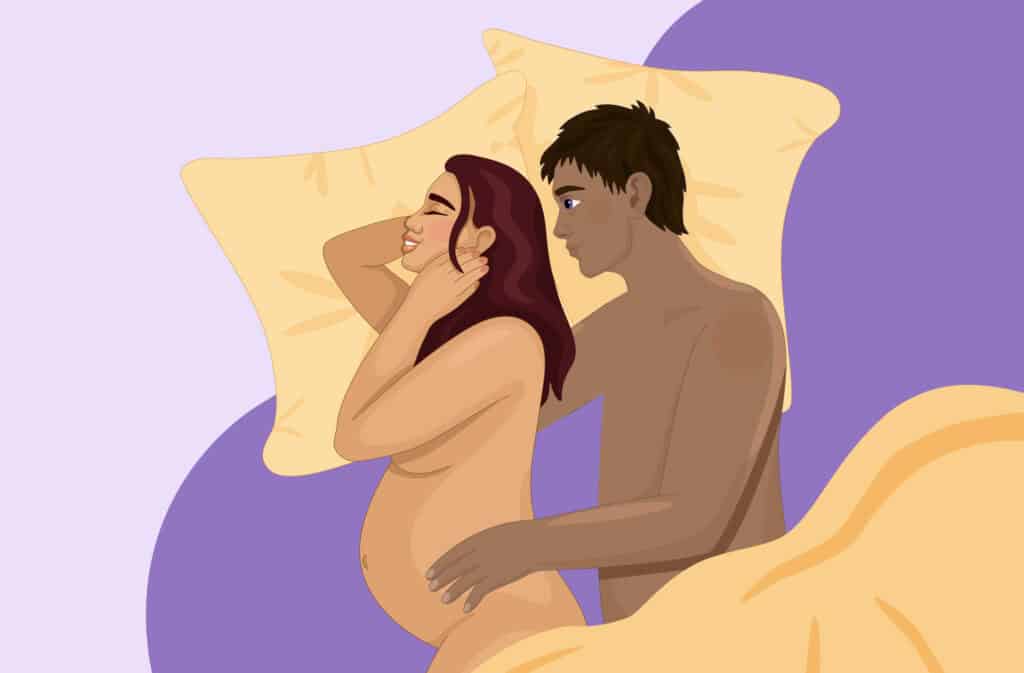
Discover safe and comfortable sex positions during pregnancy that enhance intimacy while accommodating bodily changes. Explore positions that prioritize comfort and intimacy, ensuring both partners feel connected and at ease.
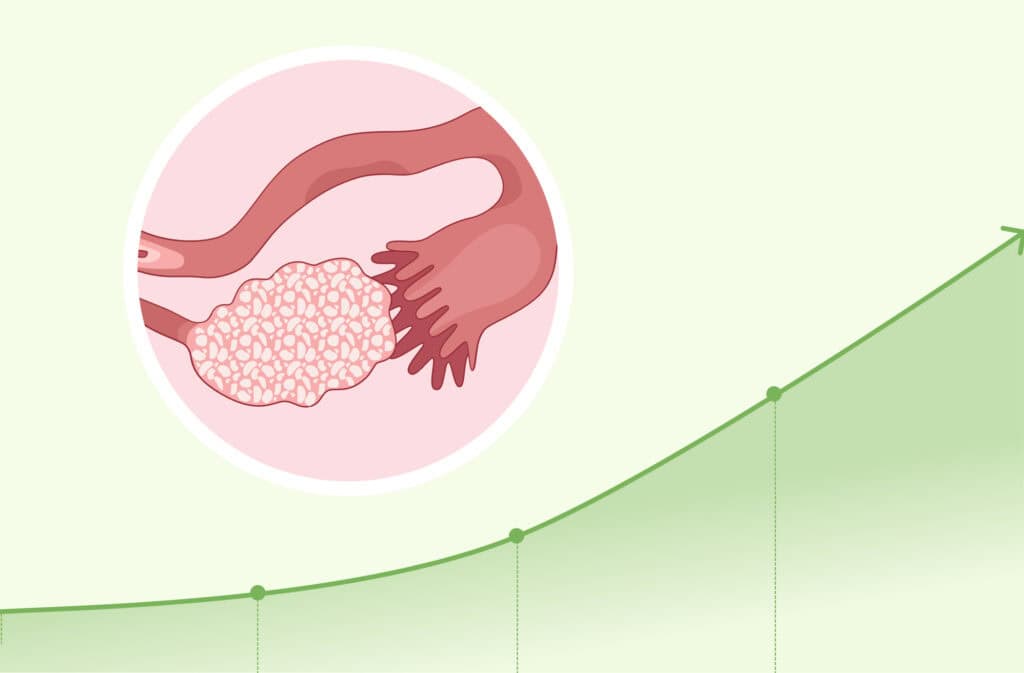
How to increase AMH levels for fertility? Click to read a definitive guide with practical tips for boosting AMH levels through dietary, lifestyle, and medical approaches.

Curious if you can eat pineapple during pregnancy? Learn if it’s safe, the myths about labor induction, and how pineapple benefits you while pregnant.

